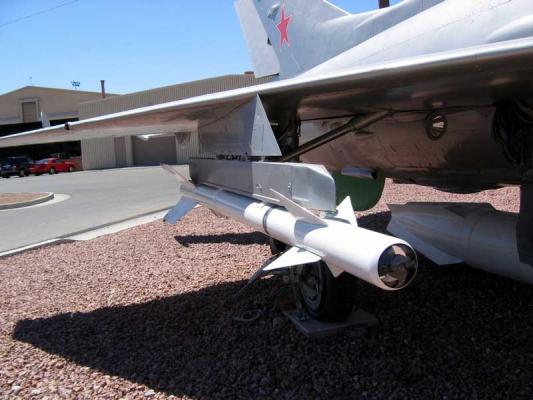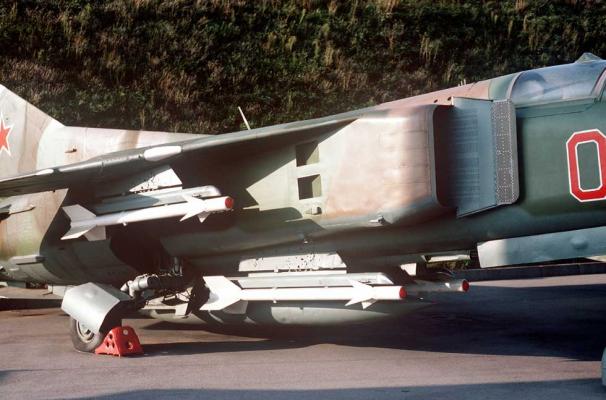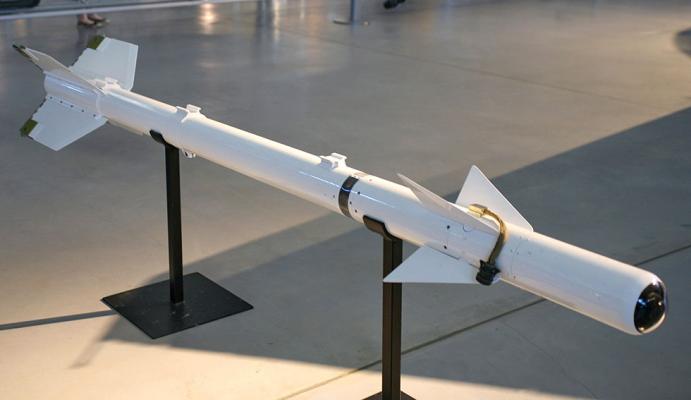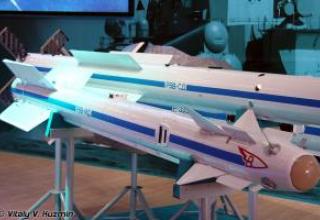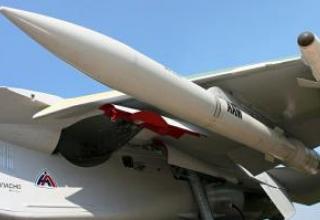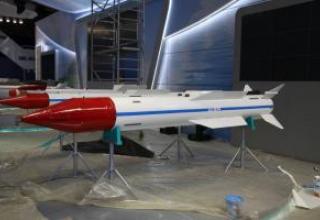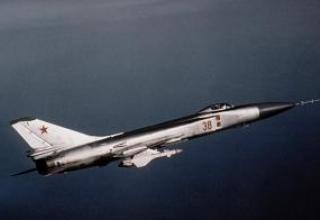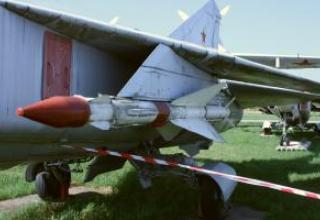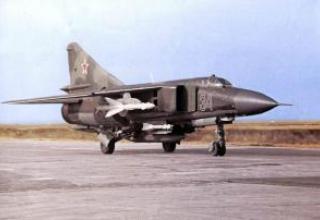The R-3C self-guided aircraft missile (K-13, item 310 and 310A) belongs to the air-to-air missile class and is intended for arming fighters attacking targets in the rear hemisphere. The missile can hit targets at any time of the day in simple meteorological conditions (outside the cloud) with long ranges and large angles. In this case, the pilot works on the principle of "shot-forget".
In early 1958, one of the samples of the American AIM-9B "Sidewinder" missile hit the USSR through China. This rocket was launched by a Taiwanese pilot during a coastal clash, did not explode and fell into the mud of a rice field. Another "Sidewinder", which hit the Chinese MiG-17 in September 1958 and did not explode, and was taken to the airfield. The study of the trophy showed that the Americans managed to create an outstanding specimen - lightweight, compact, uncomplicated structurally and in operation. The opportunity to get acquainted with the device "Sidewinder" has accelerated the work on the creation of its domestic analogue of the same class - K-13 (R-3C) missiles.
K-13 (R-3C) designed at the Design Bureau-134 under the leadership of I.I.Toropov repeated the design and main dimensions of the Sidewinder, differing in details, increased mass of the BC, as well as the engine device with a powder charge of nitroglycerin fuel. The first launches of the new rocket were already in March 1959 with the modified MiG-19, and in February 1960 it was launched into mass production at several plants.
In the course of ground testing and trials revealed the possibility of increasing the launch range of K-13 missiles on subsonic targets. However, to expand the launch area it was necessary to increase the operating time of the onboard power supply. The rocket with a modified gas generator later received the name K-13A. The Decree of the Central Committee of the CPSU and the USSR CM of August 22, 1959 999-486 to improve the tactical and technical characteristics of the missile provided for a range of launch ranges of 0.4-7.6 km, an altitude of 21.5 km and the ability to use the exchange rate angle of 65-70.
At the beginning of 1960, the advanced missiles were presented for joint tests, during which manned MiG-19, Tu-16, IL-28 and the latest MiG-21 and T-3 (Su-9) missiles were used as targets during the flight stage, and unmanned targets based on MiG-17 and IL-28 were used during actual launches. In August, the tests ended with the signing of the Act 40 of the Civil Code of the Air Forces Scientific Research Institute with the recommendation to deploy the K-13A together with the MiG-21 aircraft.
The first serial carrier of the R-3S (K-13) was the MiG-21f-13 (on the APU-3S), which retained, though in half of the reduced configuration, cannon weapons. Already in July the Gorky factory 21 has let out the first series of missile carriers. The Decree of the CPSU Central Committee and the USSR CM of October 27, 1960. 1133-476 this aircraft was adopted for service. Characteristics of the main weapons of the MiG-21 - K-13 missiles, while not determined, as work on its improved version of the K-13A with the required range of ranges still continued, moreover, with a delay in relation to the planned dates. The decree also ordered the interceptor MiG-21PF to be accelerated.
By June 1961, 32 advanced missile launches had been carried out, during which five MiG-17 targets and one IL-28 were shot down. At the end of the month the State Tests were completed. At the official adoption of the MiG-21PF Decision of March 2, 1962 were defined and the main characteristics of K-13A, named R-3C ("third - homing missile").
The R-ZS was also included in the armament and other aircraft on APU-13, -13M1, -13M5, -13BS, -13MT suspensions. Under it some MiG-17PF and MiG-19P were modified as well. With minimal changes in the design of the missile was produced and used for an unprecedented long time, not being removed from service and by the end of 80s.
In 1961, the development of high-altitude version of the K-13 with semi-active radar CNS was started, which in 1966 entered into service of MiG-21MB and MiG-21bis fighters. The CNS operated in the range of 10-20 GHz. The SD received an index P-3R (object 320). The missile was capable of intercepting targets at altitudes up to 21 km. Its range of application was from 0.3 to 15 km. In the late 1960s, the Vimpel Design Bureau began work on the K-13M missile (Object 380) with a new cooled homing head, a radio detonator and a more powerful combat unit. In 1973, the missile successfully passed the tests. Further work resulted in the appearance of a modified K-13M1 missile with modified controls. Documentation for a simplified version of the K-13VV wartime technology and the high-altitude K-13V was also developed.
The missile versions were widely supplied for export and were in service with the Air Forces of Afghanistan, Algeria, Angola, Azerbaijan, Bangladesh, China, Congo, Yugoslavia, Cuba, Egypt, Ethiopia, Finland, Hungary, India, Iraq, DPRK, Libya, Madagascar, Mongolia, Mozambique, Nigeria, Peru, Poland, Romania, Somalia, Sudan, Syria, Vietnam, Yemen and other countries. R-13 missiles were used in hostilities in Vietnam and Egypt (in 1970 and 1973). China, India and Romania launched their own licensed production facilities. In the USSR, mass production was completely curtailed by 1980. Exports of missiles continued until the end of 80s.
Composition:
The R-3S rocket is made according to the aerodynamic scheme "duck". The peculiarity of the R-3C aerodynamic scheme is a significant spread of rudders and wings along the hull length. The wings of the rocket have the form of a rectangular trapezoidal trapezoid with an angle of sweep of the front edge of 45 °. Thickness of the wings is constant on the scale. The front edge is pointy. The rudders of the missile have a triangular shape in plan with an angle of sweep of 58°. The area of the rudders is 13% of the wing area. The rocket body is cylindrical with a hemispherical nose section. On the upper outer surface of the casing there are three rope suspension units in the form of opposite directed L-shaped elements. The use of three tiers of suspension nodes instead of two is due to the desire to limit dynamic disturbances after the descent from the guided missile with a large elongation of the hull.
In the design of the R-WS, it was noteworthy to use rollers, which were designed to provide stability relative to the longitudinal axis and limit the angular velocity of the roll. Rolleron is a combination of a conventional aileron and a gear roller that protrudes from its dimensions. In flight, the roller is spun by a counter flow of up to 40-60 thousand rpm and becomes a kind of gyroscope, which responds to the angular velocity of the roll and causes the aileron deflection, soaring this roll. The simple and effective design of the rolleron, which allows you to do without a special control loop on the roll, later became a popular solution for lightweight missiles. Another innovation was the absence of a special autopilot in the control system due to the feedback not on the conventional overload, but on the articulated moment of the steering.
When suspending the missile on the carrier was carried out electrical connection between on-board and aircraft systems. Power supply from the carrier even before takeoff provided heating of the gas generator and the work of the thermal head of homing (TGSN). Detecting the enemy, the pilot aimed at the aircraft body. Deviation of the longitudinal axis of the aircraft from the direction of the target should not exceed a few degrees, so that the dynamics of air combat using missiles is not too different from the classic "gun". When you capture the target to escort TGSN in headphones sounded a beep. Carrier onboard equipment - radiodalometer or radar - provided definition of distance to the target, on the basis of which automatically determined the zone of possible launches. When entering this zone, a corresponding light signal was illuminated on the dashboard, and in the case of subsequent unacceptable proximity to the target, a "reversal" light was emitted. In addition to the range to the target, the launch was limited by the manoeuvrability of the missile. As a criterion for the possibility of hitting the maneuvering aircraft of the enemy took the overload of the carrier in tracking the target. In the event that it exceeded 2g, the launch was prohibited. At altitudes of more than 12 km, the maneuverability of the missile was falling and the launch could not be carried out already with the overload of the carrier 1.6g. R-3C could be launched at launch vehicle speeds of 900 to 2200 km/h and altitudes up to 20 km.
When you press the "start" button, the rocket's gas generator was started and then the marching engine. There was a disconnection of electric circuits of a rocket and an airplane, and for reduction of time of descent of a rocket from a guide, disconnected not sockets, and special torches cut cables, instantly releasing a rocket. The stabilization system was activated in 0.5-0.7 s after the missile descended from the guide rail. Guidance was provided by the proportional navigation method. The warhead was detonated by a non-contact fuse signal or by contact sensors placed on aerodynamic rudders. The pilot was free to manoeuvre after launch and could continue air combat or follow the attack results. Missiles could also be used against "thermal" ground targets, such as aircraft, cars and ships with engines running, and the non-contact fuse was turned off for a direct hit. When missed through 21-28c the missile was destroyed by the operation of a liquidator.
It was also possible to use the R-3S for ground targets - aircraft in the parking lots with running or unsettled engines, locomotives, boats and other heat-emitting objects, while to improve the effectiveness of the combat unit operation, the non-contact fuse was turned off before launch.
For the purpose of interchangeability and convenient installation of the R-3C is structurally made in the form of five separate separate compartments, inside which the missile equipment and units are placed.
- The first compartment is the homing head '451-K' (see description).
- The second compartment - the steering one, including the RP-310A steering drive, BP-13V3 turbogenerator and I-107 contact fuse. (see description).
- The third compartment is a shrapnel fighting unit. (see description).
- The fourth compartment is the non-contact fuse '454-K' (see description).
- The fifth compartment is a solid propellant rocket engine PRD-80A (see description).
The first and second compartments form the control compartment after assembly and joint adjustment.
Along with the combat vehicle "310" was mastered as a target used in the training launches of combat missiles target - "317", characterized by a simplified set with no steering wheels. R-ZU training missiles - mock-ups equipped with real homing heads - were also produced to develop target pointing and prelaunching skills. In order to reduce the cost of combat training, practical R-ZP missiles were also produced without a regular combat unit, which made it possible to launch several missiles at one target.
Characteristics:
| Start range at equal speeds, km | 7.6 |
| Shooting angle | 1/4 – 3/4 |
| The missile provides target engagement under conditions: - target altitude, km - target speed, km/h |
0-21.5 800 - 1600 (0.65 - 1.3 М) |
| Overall dimensions, mm: - length - diameter - wingspan |
2838 127 528 |
| Weight of a fully loaded missile, kg | 75.3 |
| Time of controlled flight, s | not less than 21 |
| Full engine pulse, Ns | 38000-40000 |
| Weight BC, kg | 11.3 |
| Temperature range of application | ±50°С |
Testing:
R-3C was baptized in battle in Vietnam and then in the Middle East. It proved to be a good weapon, unpretentious and reliable. However, TGSN R-3S was sensitive to weather conditions (rain and cloud cover absorbed infrared radiation), the attack was possible only from the rear hemisphere, and to evade it, the enemy used to evade the sun - a powerful natural source of heat (at night such a false target could be a "cold" moon). The launch performance was also affected by the missile's limited maneuverability when flying to the target, its inability to descend from the track at high overloads in combat and insufficiently powerful combat unit. The area of possible attacks was also reduced by the minimum allowed range (it was determined by the inability of the TGSN to track the target moving fast on azimuth and its own safety in case of a BC explosion).
For 1966. - the first year of use of R-ZS missiles in Vietnam, they were hit by 16 out of 57 American aircraft shot down by fighter aircraft. Their efficiency was 35% at 46 launches. Skills and more careful observance of tactical recommendations allowed next year to increase the effectiveness of missile attacks: in 53 battles MiG-21 shot down 50 planes. The overwhelming majority of R-3C launches were carried out from behind at short ranges (1200 - 2500m), only 5% of the attacks were carried out from distances over 2500m.
Shortcomings in training and tactics affected the use of missiles in the Middle East battles: sharp maneuvers of impulsive Arab pilots who did not comply with the prescribed modes of launch, led to unsuccessful launches and wasted missiles. Thus, in the group battle on November 3, 1968, the price of victory over two Israeli "Mirages" was 13 spent by the Egyptians R-3C. In the Indo-Pakistan conflict in December 1971, out of 10 victories won by Indian MiG-21, 8 were achieved with the use of guns and only 2 with the launch of R-3C.
Sources:
- Л.Н.Бызов, В.С.Вельгорский, С.Н.Ельцин "Устройство и функционирование авиационной ракеты Р-3С", СПб 2005г.
- В.Марковский, К.Перов. Развитие советских авиационных ракет класса "воздух-воздух".М-Хобби.
- К-13A, Р-3С (изделие 310)
